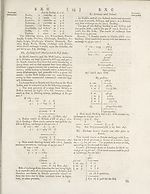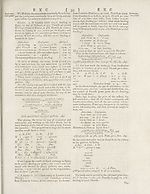Encyclopaedia Britannica > Volume 7, ETM-GOA
(70) Page 54
Download files
Complete book:
Individual page:
Thumbnail gallery: Grid view | List view

E X C L J4 1 E X C
To avoid paying the premium, it is an ufual prac¬
tice to take the bill payable at London a certain num¬
ber of days after date ; and in this way of doing, 73
days is equivalent to 1 per cent.
XII. Arbitration of Exchanges.
The courfe of exchange betwixt nation and nation
naturally rifes or falls according as the circumftanCes
and balance of trade happen to vary. Now, to draw up¬
on-and remit to foreign places, in this flu&uating date
of exchange, in the way that will turn out moil profit¬
able, is the defign of arbitration. Which is either
fimple or compound.
I. Simple Arbitration.
In fimple arbitration the rates or prices of exchange
from one place to other two are given ; whereby is
found the correfpondent price between the faid two
places, called the arbitrated price, or par of arbitration :
and hence is derived a method of drawing and remit¬
ting to the bell advantage.
ExaSip. 1. If exchange from London to Amfter-
dambe 33 s. gd. per pound Sterling; and if exchange
from London to Paris be 32 d. per crown; what mull
be the rate of exchange from Amfterdam to Paris, in
order to be put on a par with the other two ?
Ster. Flem. Ster.
s. s. d. d.
If 20 : 33 9 : : 32
12 12
240 405
32
3. If exchange fromLondon to Paris be 33d. Sterling Exchange.
per crown, and to Amfterdam 405 d. Flemifhper pound —
Sterling ; and if, by advice from Holland to France,
the courfe of exchange between Paris and Amfterdam
is fallen to 52 d. Flemifli per crown if what may be
gained per cent, by drawing on Paris, and remitting to
Amfterdam ?
The par of arbitration between Paris and Amfter¬
dam in this cafe, by Ex. 1. is 54 d. Flemiih/er crown.
Work as under.
d. St. Cr. L.St. Cr.
If 32 : x :: 100 : 750 debit at Paris
Cr. d.Fl C. d.Fl.
If 1 : 52 :: 750 : 3yo<!Jo credit at Amfterdam.
d.Fl. L.St. d. FI. L. s. d.Ster.
If 405 : 1 39000 : 96 5 11^-to be remitted.
100
3 M 4
But if the courfe of exchange between Paris and
Amfterdam, inftead of falling below, rife above the
par of arbitration, fuppofe to 56 d. Flemifhcrown ;
in this cafe, if y ou propofe to gain by the negotiation,
you muft draw on Amfterdam, and remit to Paris.
The computation follows.
L.St. d.Fl. L.St. d.Fl.
If 1 : 405 too : 40500 debit at Amfterdam.
d.F/. Cr. d. F. Cr.
If 56 : 1 :: 40500 : 723^ credit at Paris.
Cr. d.Si. Cr. L. s. d. Ster.
If 1 : 32 723^ : 96 8 6^ to be remitted.
100
810
121£
240)12960(54 d. Flem. crown. Anf.
3 11 5 t gained per cent.
In negotiations of this fort, a fum for remittance is
afforded out of the fum you receive for the draught;
and your credit at the one foreign place pays your debt
at the other.
2. If exchange from Paris to London be 32d. Ster¬
ling crown ; and if exchange from Paris to Amfter-
dam be 54d. Flemifhcrown ; what muft be the rate
of exchange between London and Amfterdam, in order
to be on a par with the other two ?
Ster. Flem. Ster.
d. d. d.
If 32 : 54 ; ; 240
240
2x6
108
12) r. d.
32)12960(405 (139 Flem.per 1. Ster. Anf.
From thefe operations it appears, that if any fum of
money be remitted, at the rates of exchange mention¬
ed, from ary one of the three places to the fecond, and
from the iecond to the third, and again from the third
to the fiift, the fum fortn itted will come home entire,
without increafe or diminution.
From the par of arbitration, thus found, and the
courfe of exe' .ivcn, is deduced a method of
drawing ai d leimtutig to advantage, as in the follow¬
ing example.
II. Compound Arbitration.
In compound arbitration the rate or price of ex¬
change between three, four, or more places, is given,
in order to find how much a remittance paffing through
them all will amount to at the laft place ; or to find
the arbitrated price, or par of arbitration, between the
firft place and the laft. And this may be done by the
following
Rules. I. Diilinguifh the given rates or prices in¬
to antecedents and confequents; place the antecedents
in one column, and the confequents in another on the
right, fronting one another by way of equation.
II. The firft antecedent, and the laft conlequent to
which an antecedent is required, muft always be of the
fame kind.
ill. The fecond antecedent muft be of the fame
kind with the firft confequent, and the third antece¬
dent of the fame kind with the fecond confequent, &c.
IV, If to any of the numbers a fradtion be annexed,
both the antecedent and its confequent muft be multi¬
plied into the denominator.
V. To facilitate the operation, terms that happen to
be equal or the fame in both columns, may be dropped
or rejedled, and other terms may be abridged.
4
VI.
To avoid paying the premium, it is an ufual prac¬
tice to take the bill payable at London a certain num¬
ber of days after date ; and in this way of doing, 73
days is equivalent to 1 per cent.
XII. Arbitration of Exchanges.
The courfe of exchange betwixt nation and nation
naturally rifes or falls according as the circumftanCes
and balance of trade happen to vary. Now, to draw up¬
on-and remit to foreign places, in this flu&uating date
of exchange, in the way that will turn out moil profit¬
able, is the defign of arbitration. Which is either
fimple or compound.
I. Simple Arbitration.
In fimple arbitration the rates or prices of exchange
from one place to other two are given ; whereby is
found the correfpondent price between the faid two
places, called the arbitrated price, or par of arbitration :
and hence is derived a method of drawing and remit¬
ting to the bell advantage.
ExaSip. 1. If exchange from London to Amfter-
dambe 33 s. gd. per pound Sterling; and if exchange
from London to Paris be 32 d. per crown; what mull
be the rate of exchange from Amfterdam to Paris, in
order to be put on a par with the other two ?
Ster. Flem. Ster.
s. s. d. d.
If 20 : 33 9 : : 32
12 12
240 405
32
3. If exchange fromLondon to Paris be 33d. Sterling Exchange.
per crown, and to Amfterdam 405 d. Flemifhper pound —
Sterling ; and if, by advice from Holland to France,
the courfe of exchange between Paris and Amfterdam
is fallen to 52 d. Flemifli per crown if what may be
gained per cent, by drawing on Paris, and remitting to
Amfterdam ?
The par of arbitration between Paris and Amfter¬
dam in this cafe, by Ex. 1. is 54 d. Flemiih/er crown.
Work as under.
d. St. Cr. L.St. Cr.
If 32 : x :: 100 : 750 debit at Paris
Cr. d.Fl C. d.Fl.
If 1 : 52 :: 750 : 3yo<!Jo credit at Amfterdam.
d.Fl. L.St. d. FI. L. s. d.Ster.
If 405 : 1 39000 : 96 5 11^-to be remitted.
100
3 M 4
But if the courfe of exchange between Paris and
Amfterdam, inftead of falling below, rife above the
par of arbitration, fuppofe to 56 d. Flemifhcrown ;
in this cafe, if y ou propofe to gain by the negotiation,
you muft draw on Amfterdam, and remit to Paris.
The computation follows.
L.St. d.Fl. L.St. d.Fl.
If 1 : 405 too : 40500 debit at Amfterdam.
d.F/. Cr. d. F. Cr.
If 56 : 1 :: 40500 : 723^ credit at Paris.
Cr. d.Si. Cr. L. s. d. Ster.
If 1 : 32 723^ : 96 8 6^ to be remitted.
100
810
121£
240)12960(54 d. Flem. crown. Anf.
3 11 5 t gained per cent.
In negotiations of this fort, a fum for remittance is
afforded out of the fum you receive for the draught;
and your credit at the one foreign place pays your debt
at the other.
2. If exchange from Paris to London be 32d. Ster¬
ling crown ; and if exchange from Paris to Amfter-
dam be 54d. Flemifhcrown ; what muft be the rate
of exchange between London and Amfterdam, in order
to be on a par with the other two ?
Ster. Flem. Ster.
d. d. d.
If 32 : 54 ; ; 240
240
2x6
108
12) r. d.
32)12960(405 (139 Flem.per 1. Ster. Anf.
From thefe operations it appears, that if any fum of
money be remitted, at the rates of exchange mention¬
ed, from ary one of the three places to the fecond, and
from the iecond to the third, and again from the third
to the fiift, the fum fortn itted will come home entire,
without increafe or diminution.
From the par of arbitration, thus found, and the
courfe of exe' .ivcn, is deduced a method of
drawing ai d leimtutig to advantage, as in the follow¬
ing example.
II. Compound Arbitration.
In compound arbitration the rate or price of ex¬
change between three, four, or more places, is given,
in order to find how much a remittance paffing through
them all will amount to at the laft place ; or to find
the arbitrated price, or par of arbitration, between the
firft place and the laft. And this may be done by the
following
Rules. I. Diilinguifh the given rates or prices in¬
to antecedents and confequents; place the antecedents
in one column, and the confequents in another on the
right, fronting one another by way of equation.
II. The firft antecedent, and the laft conlequent to
which an antecedent is required, muft always be of the
fame kind.
ill. The fecond antecedent muft be of the fame
kind with the firft confequent, and the third antece¬
dent of the fame kind with the fecond confequent, &c.
IV, If to any of the numbers a fradtion be annexed,
both the antecedent and its confequent muft be multi¬
plied into the denominator.
V. To facilitate the operation, terms that happen to
be equal or the fame in both columns, may be dropped
or rejedled, and other terms may be abridged.
4
VI.
Set display mode to:
![]() Universal Viewer |
Universal Viewer | ![]() Mirador |
Large image | Transcription
Mirador |
Large image | Transcription
Images and transcriptions on this page, including medium image downloads, may be used under the Creative Commons Attribution 4.0 International Licence unless otherwise stated. ![]()
| Encyclopaedia Britannica > Encyclopaedia Britannica > Volume 7, ETM-GOA > (70) Page 54 |
|---|
| Permanent URL | https://digital.nls.uk/189122139 |
|---|
| Attribution and copyright: |
|
|---|
| Description | Ten editions of 'Encyclopaedia Britannica', issued from 1768-1903, in 231 volumes. Originally issued in 100 weekly parts (3 volumes) between 1768 and 1771 by publishers: Colin Macfarquhar and Andrew Bell (Edinburgh); editor: William Smellie: engraver: Andrew Bell. Expanded editions in the 19th century featured more volumes and contributions from leading experts in their fields. Managed and published in Edinburgh up to the 9th edition (25 volumes, from 1875-1889); the 10th edition (1902-1903) re-issued the 9th edition, with 11 supplementary volumes. |
|---|---|
| Additional NLS resources: |
|

